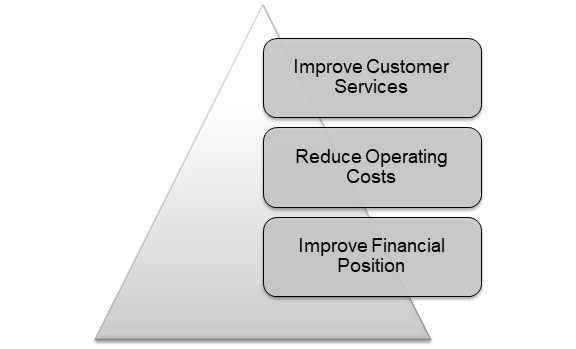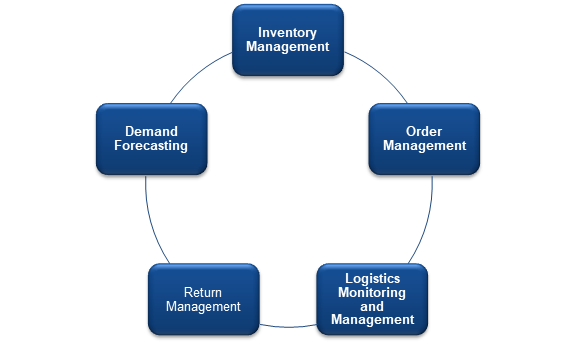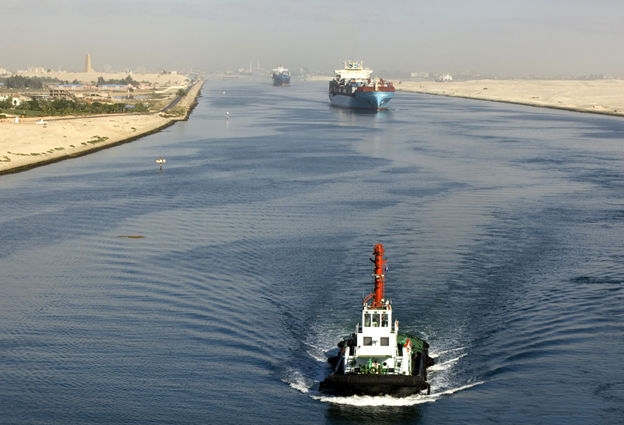Supply Chain Management or SCM is a holistic approach towards handling, managing and coordinating the flow of materials in and out of the organisation. It starts from the raw materials (components) from the point of origin all the way to the delivery of the finished product or goods to the customers.
No organisation wants to build up a large inventory of raw materials or final product. Maintaining an inventory involves costs, and to minimise this cost, an effective supply chain system is required. Each component of the raw materials needs to be made available at the designated time, and the finished product needs to leave the inventory in time to make room for the fresh batch. All operation must be synchronised in such a way that the production does not get hampered.
Why is SCM required?
The SCM's main objective is to provide a cost-effective management system that can optimise the entire production cycle. There should be no lag in the supply of raw materials to prompt the release of items to the designated customers or clients.
The SCM has evolved over the years and has become smart enough that they use the database for effective calculation of the items in inventory and the average time for replenishment of the stocks. The entire process has become automatic, and with the advent of artificial intelligence (AI), the system will become robust in the future. SCM is required to handle the supply of the finished items' materials and demand with proper logistics in place.

Copyright © 2021 Kalkine Media Pty Ltd.
What are the main components of effective SCM?
The main components of an effective SCM system are as follows:
- Information
To remain abreast in the business, the flow of correct and relevant information is crucial. To know the market trends, demand and supply scenario of a particular product will help in focusing the SCM towards catering to the particular section.
- Planning
Planning is required at every stage of any business. Once appropriate data and information are gathered and analysed, planning should be done to implement the SCM. In this step, budget planning, human resource requirement, equipment, and machinery requirements are made.
Performance metrices are also established to check the system's effectiveness and analyse if the system is sufficiently able to meet the goal.
- Source
Suppliers play a key role in any supply chain system. They possess the raw materials required to support the production cycle. So its became crucial for an organisation to maintain the relationship with the suppliers to avail quality raw materials at a competitive price and on the stipulated time.
- Inventory
An optimum inventory is required for any manufacturing or service industry. For an industry, few items are highly consumable, while some takes sit for even months. These items are carefully identified and maintained at their respective consumption speed.
- Production
For quality production or manufacturing operation, quality raw materials are sourced on time. The testing of incoming supplies before using them in the production system is also part of the job.
- Distribution and Logistics
After a product or item is ready, it needs to reach the customers based on their demand. There are industries that deal in perishable items. They need their product on the shelf of supermarkets and convenience stores within hours from manufacturing. Logistics play a key role, and to manage and monitor the entire operation, SCM is employed.
What are the key features required in an effective SCM?
The supply chain is the backbone of a manufacturing company. The quality of the product does not matter when it could not reach the consumer or customers on time. The SCM operates in any organisation's backstage operation but plays a key role in making the brand or company reputation.
To develop a successful and effective SCM, it should have the below listed features to be incorporated in the SCM.

Copyright © 2021 Kalkine Media Pty Ltd.
Case Study
Suez Canal blockage by MV Ever Given
The heartbeat of world trade started pacing when a merchant vessel MV Ever Given blocked the Suez Canal. The canal facilitates the smooth and speedy movement of goods between Asia, Europe and Africa. The estimates are that the Suez Canal alone handles over 12% of the world's trade, and on average, roughly 50-55 ships pass through the narrow passage daily.

File photo of vessels passing through the canal (Image source: Dpsfotogmailcom, Megapixl.com)
A Pennames Flag bearing container ship on its route to the Netherlands reportedly lost control due to wind and wedged across the canal. The rear end of the ship was struck in the sands at the shore of the canal, obstructing the traffic from both sides.
It took nearly a week time to free the ship and bon voyage it to its original destination. It is estimated that the blockage was causing a loss of US$9 billion every day to world trade. It is a key route for oil tankers also.
Various media houses reported that the blockage would cause a severe shortage of toilet papers. The alternate route from Cape of Good Hope will take significant time and increase the logistics cost.
So, a severe logistics issue crept in when the ship got stuck in the canal. A robust SCM will enable the system to know the demand and supply of the goods in the market. Based on the data, a decision could be reached whether to wait for clearing the course of the canal or to take the alternative route to reach the market, keeping cost efficiency also in the frame. The canal finally cleared off after a week but may be enough for delays in shipments and price fluctuations in some of the commodities.
 Please wait processing your request...
Please wait processing your request...